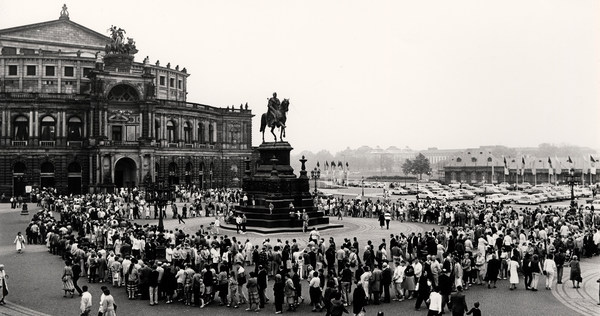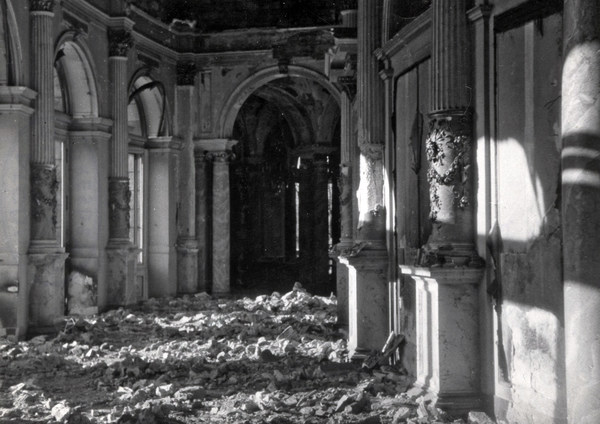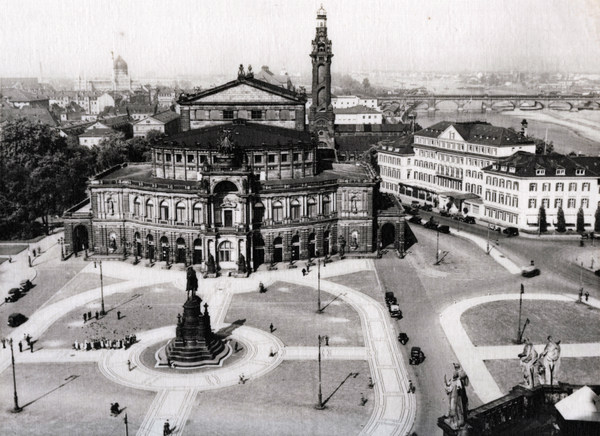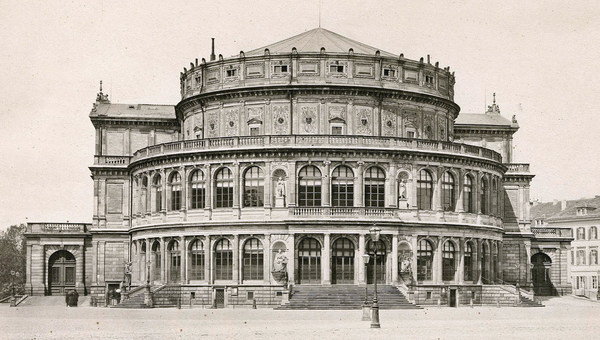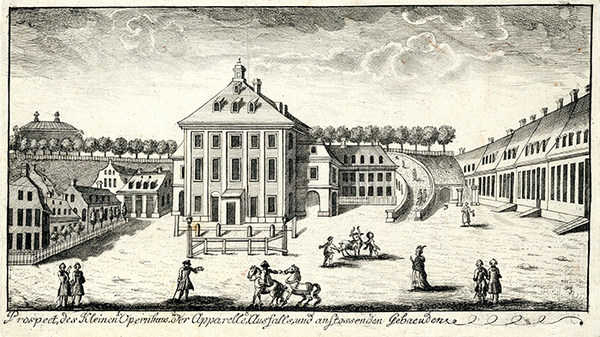History of the Semperoper
Overall
The history of opera in Dresden goes back to the opening of the city’s first opera house in 1667. Under the baton of Hofkapellmeister Johann Adolph Hasse, Dresden rose to prominence as a lively centre of European opera. When the Royal Saxon Theatre opened its doors in 1817, audiences could enjoy Italian and (somewhat later) German opera in addition to drama. Carl Maria von Weber headed the so-called German Department. »Rienzi«, »The Flying Dutchman« and »Tannhäuser« all premiered here after Richard Wagner’s appointment as Hofkapellmeister in 1843. Ernst von Schuch, who was Generalmusikdirektor from 1889 to 1914, conducted over 40 world premieres, including Richard Strauss’s »Salome«, »Elektra« and »Der Rosenkavalier«. Five more of the composer’s operas were premiered in Dresden up to the year 1938. Under Schuch’s successor, Fritz Busch, the repertoire in Dresden was expanded to include modernist works, such as the world premieres of pieces by Weill and Hindemith.
The Staatskapelle Dresden, one of the most world’s most prestigious orchestras, was founded in 1548. Its principal conductors and music directors have included Karl Böhm, Kurt Sanderling, Herbert Blomstedt, Giuseppe Sinopoli, Bernard Haitink and Fabio Luisi. Christian Thielemann has been principal conductor of the Staatskapelle since 2012, and he will be succeeded by Daniele Gatti from the 2024/25 season.
With a diverse repertoire ranging from traditional narrative ballets to contemporary dance, the company of the Semperoper Ballett sets international standards with a select group of brilliant soloists. Since the 2023/24 season, Marcelo Gomes as Artistic Manager and Adi Luick as Company Manager assume joint responsibility for Dresden’s ballet company, which is internationally in demand. From the beginning of the 2024/25 season, Kinsun Chan will continue to shape the diverse repertoire of the Semperoper Ballett with his artistic signature as the new Artistic Director until initially the end of the 2027/28 season.
After Gottfried Semper’s first theatre from 1841 burned down in 1869, the opera was opened in its present design in 1878. When this building was destroyed by the air raids of 1945, Saxon State Opera became »homeless« until the reconstructed Semperoper was officially opened in 1985.
Wolfgang Rothe has been commercial director of the Semperoper Dresden since 2005, and since January 2013 has also been in charge of Saxon State Theatres, an institution created out of the former State Opera and State Theatre. From 2012 to 2018 Wolfgang Rothe was also acting Intendant of the Semperoper.
Since the 2018/19 season, Peter Theiler from Switzerland has taken over the reins as Intendant of the Semperoper. Nora Schmid will become the new Intendant of the Sächsische Staatsoper Dresden from the 2024/25 season.
3rd opera house
Third opera house of Gottfried Semper
1985
On 13 February, 40 years after its destruction, the Semperoper finally reopens to great celebration. Every evening one of the most beautiful opera houses in the world welcomes local citizens and visitors from near and far. The inaugural performance is Carl Maria von Weber’s »Der Freischütz«.
The following world premieres (wp) and German premieres (Gp) have been held in the Semperoper since its reopening:
- »Die Weise von Liebe und Tod des Cornets Christoph Rilke« by Siegfried Matthus (wp in 1985)
- »Celan« by Peter Ruzicka (wp in 2001)
- »The Good God of Manhattan« by Adriana Hölszky (wp in 2005)
- »Dead Man Walking« by Jake Heggie and Terrence McNally (Gp in 2006)
- »La grande magia« by Manfred Trojahn (wp in 2008)
- »Gisela! oder: Die merk- und denkwürdigen Wege des Glücks« by Hans Werner Henze (wp of the revised version in 2010)
- »The Great Gatsby« by John Harbison (Gp in 2015)
- »The killer in me is the killer in you my love« by Ali N. Askin (commissioned by the Sächsische Staatsoper Dresden, wp in 2016)
- »The Four Seasons« by David Dawson (wp 2018 as part of the multi-part ballet evening »A Midsummer Night’s dream«)
- »Songs for a Siren« by Joseph Hernandez (wp 2018 as part of the multi-part ballet evening »Labyrinth«)
- »4.48 Psychose« by Philip Venables (Gp in 2019)
- »Alice – A Journey to Wonderland« by Raphaël Coumes-Marquet, Joseph Hernandez, Houston Thomas, James Potter and Michael Tucker (wp in 2019)
- »These Arms« by Nicholas Palmquist and »A List of Beginnings« by Joseph Hernandez (wp in 2020 as part of the ballet gala »We will dance!«)
- »A Collection of Short Stories« by Nicholas Palmquist (wp in 2021 as part of the multi-ballet evening »A Collection of Short Stories«)
- Prologue by Manfred Trojahn to »Don Carlo« by Giuseppe Verdi (wp in 2021)
- »The Bald Soprano« by Luciano Chailly (Gp in 2022)
- »The Other Wife« by Torsten Rasch (commissioned by the Sächsische Staatsoper Dresden, wp in 2022)
Between the 2nd and 3rd Semperoper
The period between the second and third Semperoper
1945
During the bombing of Dresden on 13-14 February, the Semperoper, like all Dresden theatres, was almost completely destroyed.
The first interim venue is the converted Tonhalle in Dresden-Neustadt (which later became the »Kleine Haus«). The first opera to be performed after the second world war is Mozart’s »The Marriage of Figaro«, staged here on 10 August. A further interim venue is the Kurhaus Bühlau.
1948
On 22 September (the 400th anniversary of the founding of the Staatskapelle), the rebuilt Schauspielhaus opens with a performance of Beethoven’s “Fidelio”. As the “Great House of Dresden State Theatre”, it serves as the main venue for opera and ballet until 1984. Leading conductors to leave their mark here include Joseph Keilberth, Rudolf Kempe, Franz Konwitschny, Otmar Suitner, Rudolf Neuhaus and Siegfried Kurz; directors such as Heinz Arnold, Alfred Eichhorn, Erich Geiger, Harry Kupfer, Joachim Herz and Christine Mielitz create many influential productions. The list of world premieres and first performances include: »Antigonae« by Carl Orff (1950), »Die Liebe der Danae« by Richard Strauss (1952), »The Love for Three Oranges« by Sergei Prokofiev (1958), »The Young Lord« by Hans Werner Henze (1967), »Wozzeck« by Alban Berg (1970), »Levins Mühle« and »Der Schuhu und die fliegende Prinzessin« by Udo Zimmermann (world premieres in 1973 and 1976), »Moses und Aron« by Arnold Schoenberg (1975) and »Vincent« by Rainer Kunad (world premiere in 1979).
1977
Following measures to secure the remains of the building, thorough studies of preserved documents as well as a lengthy planning phase and project preparation, the foundation stone for the reconstruction of the Semperoper is laid on 24 June. The chief architect is Wolfgang Hänsch.
1984
The resurrected third Semperoper is handed over to the State Opera for a test run of technical and artistic operations.
2nd opera house
Second opera house by Gottfried Semper
1878
The second Royal Court Theatre by Gottfried Semper – constructed between 1871 and 1878 under the supervision of Semper’s son Manfred – opens on 2 February with (once again) Weber’s »Jubilee Opera« and Goethe’s »Iphigenie auf Tauris«. Until 1895 this magnificent theatre is used to stage both opera and plays. From 1896 there are daily opera performances.
Under Generalmusikdirektor Ernst von Schuch, who from 1882 also headed the Dresden Court Opera, the world-renowned and lengthy association with Richard Strauss took root with the world premieres of »Feuersnot« (1901), »Salome« (1905), »Elektra« (1909) and »Der Rosenkavalier« (1911). In addition, von Schuch made an unforgettable name for himself with many other world premieres and first performances, through his championing of the work of Verdi and Puccini as well as the extraordinary range of his repertoire. Important singers from this time include Therese Malten, Marie Wittich, Clementine Schuch, Erika Wedekind, Margarethe Siems, Eva von der Osten, Karel Burrian, Fritz Vogelstrom, Alfred von Bary, Carl Perron and Karl Scheidemantel.
1919
Transformation of the Court Theatre into the »Saxon State Theatre«
1922
With the appointment of Fritz Busch as Generalmusikdirektor and opera director, an equally brilliant period of Dresden opera followed that of Ernst von Schuch in the second Semperoper. Until 1933, when Fritz Busch was driven out by the National Socialists, he had made his mark not only as an outstanding interpreter of the music of Strauss, Verdi and Puccini but also through his great interpretations of Mozart, Wagner, Tchaikovsky, Mussorgsky and many other composers. In addition to the premieres of Richard Strauss’s »Intermezzo« (1924), »Die Ägyptische Helena« (1928) and »Arabella« (1933), which he planned and was preparing before Clemens Krauss took over, he also conducted the premieres of Ferruccio Busoni’s »Doktor Faust« (1925), Kurt Weill’s »Der Protagonist« (1926) and Paul Hindemith’s »Cardillac« (1926).
The outstanding ensemble of singers at this time included Meta Seinemeyer, Liesel von Schuch, Elisabeth Rethberg, Erna Berger, Maria Cebotari, Richard Tauber, Max Lorenz, Tino Pattiera, Friedrich Plaschke, Robert Burg, Paul Schöffler, Kurt Böhme, Sven Nilsson and Ludwig Ermold.
1934
Karl Böhm’s appointment as Generalmusikdirektor and opera director secures the historical continuity and international artistic reputation of the Semperoper. During his tenure in Dresden, Karl Böhm premieres the Richard Strauss operas »Die schweigsame Frau« (1935) and »Daphne« (1938). He also had a first-rate ensemble of singers at his disposal, which he expanded by hiring such great names as Marta Fuchs, Margarete Teschemacher, Christel Goltz, Elfride Trötschel, Erna Sack, Elisabeth Reichelt, Torsten Ralf, Josef Herrmann, Mathieu Ahlersmeyer, Arno Schellenberg, Gottlob Frick and Heinrich Pflanzl.
1944
On 31 August, the Semperoper closes its doors during the period of »total war«. The final performance is Carl Maria von Weber’s »Der Freischütz«.
1st opera house
First opera house by Gottfried Semper
1841
The first Royal Court Theatre by Gottfried Semper, built between 1838 and 1841, opens on 12 April with a performance of Carl Maria von Weber’s »Jubilee Overture« and Johann Wolfgang von Goethe’s »Torquato Tasso«. Semper’s rounded design was regarded as the »most beautiful theatre in the world«.
Richard Wagner, the Royal Saxon Kapellmeister from 1843 to 1849, premiered his operas »Rienzi« (1842), »The Flying Dutchman« (1843) and »Tannhäuser« (1845) here.
1869
The first Semper building burns to the ground on 21 September. Only a few weeks later, on 2 December of the same year, a rapidly erected interim theatre opens: the so-called »Bretterbude« (»wooden shack«). Weber’s »Jubilee Overture« is once again played at the inauguration, while Goethe’s »Iphigenie auf Tauris« is the opening premiere. Conductor Ernst Schuch, who in the decades to come would greatly influence the artistic reputation of the Dresden Opera, began his work in the city in this theatre.
1873
According to designs by architect Bernhard Schreiber, another theatre opens in Dresden on 20 September: the Albert Theatre, named after the Saxon crown prince. For the first time, a Dresden theatre is built by local citizens rather than the court. However, the building is later leased by the Royal General Directorate and subsequently transferred into royal ownership.
Before the opening of Semper’s 1st court theatre
Before the opening of Gottfried Semper’s first court theatre
1627
40 years before the opening of the first permanent opera house, Heinrich Schütz’s »Dafne« premieres on 13 April at a royal wedding in Schloss Hartenfels near Torgau. This earliest of German operas (whose score remains lost to this day) is performed by Dresden singers and members of the Dresden Kapelle (whose origin can be traced back to the deed of foundation of 22 September 1548, the so-called »Cantorey Decree«).
1667
On 27 January, the »Klengelsche« opera house, also known as the »Prince Elector Opera House on the Taschenberg« opens with a performance of Giovanni Andrea Moneglia’s »Il Teseo«. This building, based on a design by Chief Saxon Architect Wolf Caspar von Klengel, is the earliest precursor to the Semperoper. This date is considered the official founding day of Dresden Opera, the third opera house – after Vienna (1651) and Munich (1657) – to be built in the German-speaking nations. The repertoire is dominated by operas and ballets based on Italian models.
1719
Under King Augustus the Strong, Italian master builders Alessandro and Girolamo Mauro, together with Matthäus Pöppelmann and Balthasar Permoser (the two creators of the Dresden Zwinger), erect an imposing opera building: the Great Opera House at the Zwinger. Opening on 3 September with Antonio Lotti’s »Giove in Argo«, this was not only the biggest theatre in Germany at the time but also one of the largest and most magnificent in the whole of Europe. It became the centre of Baroque opera, closely linked to Johann Adolf Hasse, a central figure in one of the most brilliant epochs of Dresden’s opera history, as well as Johann Gottlieb Naumann. Later used as a concert hall, the Great Opera House at the Zwinger saw Felix Mendelssohn Bartholdy’s conduct his oratorio »Paulus« in 1843, while on 5 April 1846 Richard Wagner directed a notable performance of Beethoven’s Ninth Symphony.
1755
The impresario Pietro Moretti builds another theatre near the Zwinger: the Moretti Theatre, also known as the Small Court Theatre to distinguish it from the existing Great Opera House at the Zwinger. Carl Maria von Weber is active here; in 1817 he founds the Dresden Opera Chorus. In the mid-1830s, the theatre is demolished to make way for a new building, namely Gottfried Semper’s first Royal Court Theatre.

